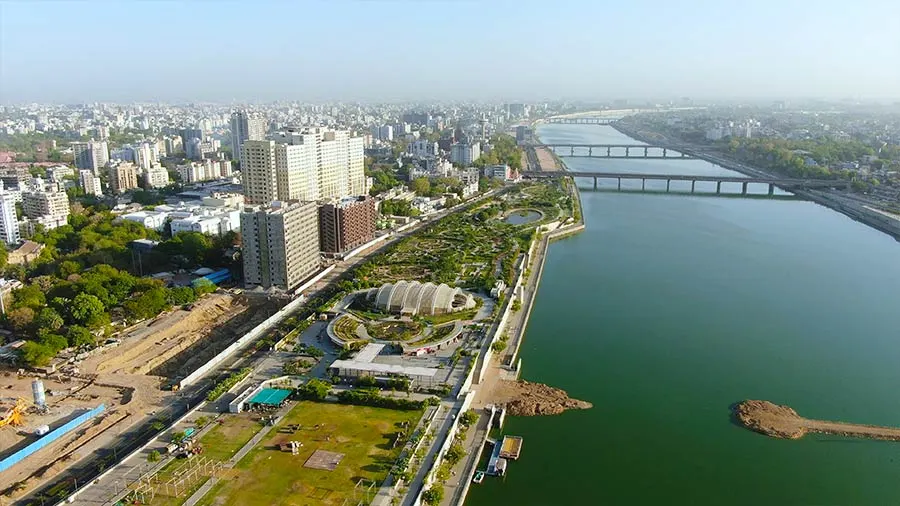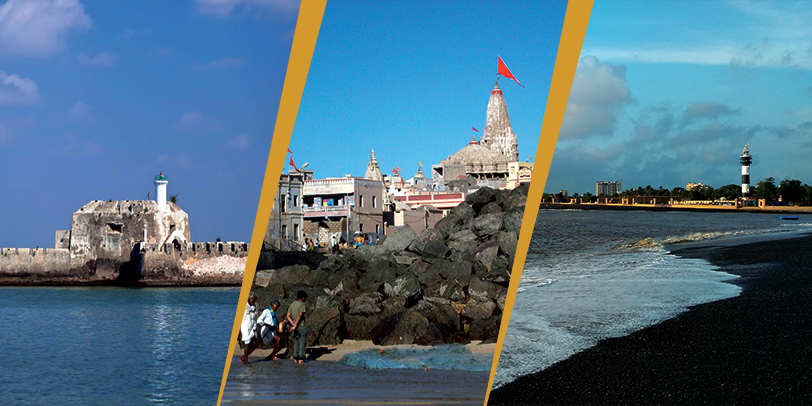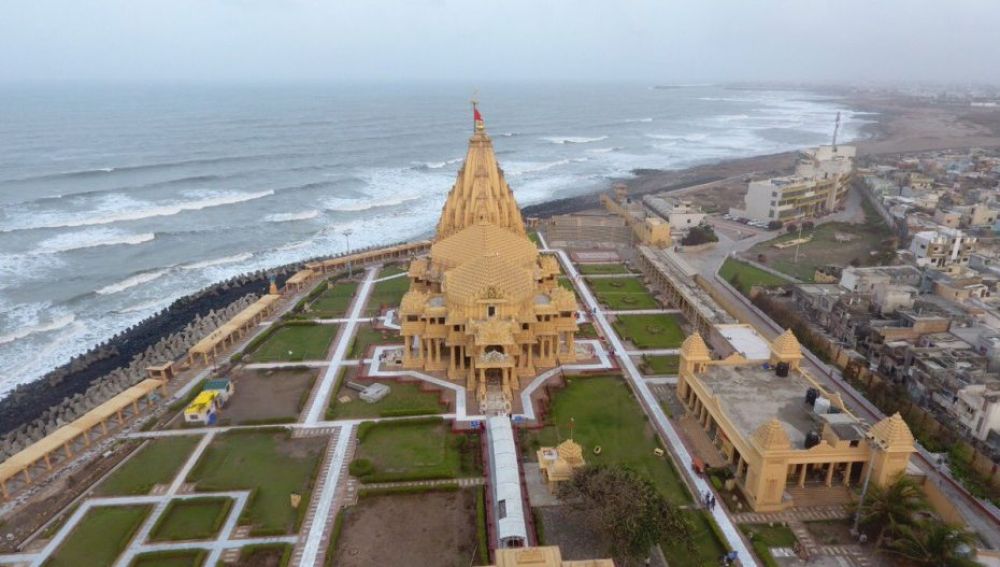Description
OVERVIEW
Embark on a captivating temple tour through Gujarat, beginning in Ahmedabad and journeying to Dakor, home to the revered Dakor Temple dedicated to Lord Ranchhodrai. Explore the ancient pilgrimage site of Pavagadh with its hilltop temples and historic significance. Continue to Dwarka, a sacred city associated with Lord Krishna, where you can visit the famous Dwarkadhish Temple and Bet Dwarka island. From Dwarka, head to Somnath to pay homage at the renowned Somnath Temple, one of the 12 Jyotirlinga shrines dedicated to Lord Shiva. Conclude your temple odyssey in Bhavnagar, where you can explore the city’s spiritual sites and soak in the cultural heritage of Gujarat. This temple tour promises a blend of spirituality, history, and architectural wonders across diverse destinations in Gujarat.
TOUR ITINERARY
DAY 01: ARRIVE AHMEDABAD (BY AIR / TRAIN)
Upon Arrive at Ahmedabad our representative will assist and transfer to your hotel.
Ahmedabad is Located on the banks of the river Sabarmati; the city was founded by Sultan Ahmad Shah in 1411. Today it is one of the fastest growing cities of India and is an immense repository of tradition, history & culture. Its famous walled area is one of the finest examples of community living & the city thrived as the textile capital & was nicknamed “Manchester of the East’ in 1888. This multicultural city is home to some of the finest Indo-Saracenic mosques & Jain temples.
The old city of Ahmedabad is dotted with labyrinthine by-lanes called ‘polls’. The exquisite carved wooden mansions and havelis are marvelous. The city also offers a rich architectural legacy that blends Hindu and Muslim schools of architecture, stone and brick with arches, domes and vaults, carved pillars, trefoil designs besides the modern buildings designed by the famous French architect, Le Corbusier and Louis Kahn.
Later proceed for city tour of Ahmedabad.
Gandhi Ashram: On a quiet peaceful stretch of the Sabarmati River, Mahatma Gandhi set up a simple retreat in 1915. This was his Satyagrah Ashram and for many years it was the nerve centre of India’s freedom movement. It was from here, in 1930, that Mahatma began his famous Dandi March to the sea to protest the Salt Tax imposed by the British. Hridaya Kunj, the simple cottage where he lived, is now a national monument and preserved as it was during the Mahatma’s lifetime. Must pick gifts and souvenirs from the Ashram shop. Spend a little time here by the river watching the parrots and the squirrels. Peace and tranquility prevail here.
Sidi Sayed Mosque: One part of the wall in the old citadel of the mosque built by Ahmed Shah’s slave, Sidi Sayed, is celebrated the world over for its exquisite stone window tracery – a superb & peerless example of delicate carving that transforms stone into filigree.
Hutheesingh Jain Temple: Built outside the Delhi Gate in 1850 by a rich Jain merchant, the Hutheesingh Temple is the best known of Ahmedabad’s many ornate Jain temples.
Adalaj Step-well: Step wells were built in olden times to serve the man purposes of – holding rainwater for later use, a resting place for the travellers, a watering hole for the travellers who had caravans and animals with them. Best examples of rainwater harvesting! The Adalaj step well is situated 17kms north of Ahmedabad. The step well at the village of Adalaj is another fine example of this magnificent architectural form. Adalaj Vav is richly carved, every pillar and wall surface covered with leaves and flowers, birds and fishes and friezes of ornamental designs.
Akshardham: Lord Swaminarayan, born in Chapaya in Uttar Pradesh, took a seven-year pilgrimage in Gujarat to preach his religion. He built six temples, the first being at Kalupur in Ahmedabad. Akshardham, the Swaminarayan temple of Gandhinagar, is a modern complex, built in traditional Indian architectural style from 6,000 metric tons of pink Rajasthan sandstone, carved by expert artisans from Bansipahadpur. The temple is set in a multi-acre garden called Sahajanand Van, with intricate sculptures of Hindu Gods. There is a gold leaf copper sculpture of Lord Swaminarayan that faces similar sculptures of Gunatinand Swami. The interiors have beautiful columns in rosewood that rise up to a high dome. Akshardham remains closed on Mondays.
OVERNIGHT AT HOTEL IN AHMEDABAD
DAY 02: AHMEDABAD-DAKOR-PAVAGADH-AHMEDABAD (BY ROAD)
Today after breakfast proceed for a day excursion to Dakor and Pavagadh.
Dakor, in its earlier phases as pilgrimage centre in Gujarat, was famous for the Danknath temple, a place of Shiva worship. In the later phases, it developed into a Vaishnavites centre with the growing fame of Ranchhodraiji temple, which was built in 1772 A.D. Today this place is known not only as a pilgrimage centre but also a trading centre where one can get the articles related to puja, and other rituals.
Pavagadh: Most of the Hindus in India have faith in goddess Mahakali, particularly from the western region covering the states of Gujarat, Rajasthan & Maharashtra. The famous and the oldest temple of Mahakali is situated at Pavagadh, near Vadodara, one of the main cities of Gujarat. The temple has become the place of the pilgrimage for almost all Hindus in India. This temple is among the three main Shaktipeeths in Gujarat. It has been said in Hindu Shastras that after the famous Tandava dance of Lord Shiva, the various parts of the body of Sati fell at many places. These places are called Shaktipeeths. It is said that the left breast of the Sati had fallen here at Pavagadh. As the name suggests, the temple is located on a mountain, near to the Champaner town. Later drive back to Ahmedabad.
OVERNIGHT AT HOTEL IN AHMEDABAD
DAY 03: AHMEDABAD TO DWARKA (BY ROAD 450 KMS / 09 HRS)
After breakfast drive to Dwarka, arrive at Dwarka and transfer to your hotel.
Dwarka: An ancient city, housing one of the principal pilgrimages – ‘Dwarkadhish temple’ of Hindus. According to the legend, Lord Krishna moved to this coastal town to set up a capital. Marine excavations of the Dwarka coast have revealed important evidence of ancient city, which probably include the ‘Dwarawati’ of the ‘Krishna Lila’. Today, it is not only a major pilgrimage site but a pleasant spot for a beach holiday. Another popular place in Dwarka, part of the Dwarkadhish Temple is Sabha Mandapa. It is a 60-pillared hall, which houses almost 2500 years old scriptures. The hall has ‘Jharokhas’, offering a nice view of the nearby flowing Gomati River. Attending evening Aarti at Dwarkadhish temple.
OVERNIGHT AT HOTEL IN DWARKA
DAY 04: DWARKA SIGHTSEEING
After breakfast visit Bet Dwarka & Nageshwar temple.
Bet Dwarka: Bet is situated at 30kms from Dwarka and is surrounded by sea from all sides. One can reach Bet from Dwarka through Okha by road. On reaching Okha port jetty, one can reach Bet through a little sea journey by a small boat.
Nageshwar Temple or Nagnath Temple is located on the route between Gomati Dwarka and the Bet Dwarka Island on the coast of Saurashtra in Gujarat. The Jyotirlinga enshrined in the Temple of Nagnath is known as Nageshwar Mahadev and attracts thousands of pilgrims all around the year. This powerful Jyotirlinga symbolizes protection from all poisons. It is said that those who pray to the Nageshwar Lingaa become free of poison. The Rudra Samhita shloka refers to Nageshwar with the phrase ‘Daarukaavane Naagesham’.
The Rukmini temple, dating from 12 to 13 Century, was built in honour of Rani Rukmani, princess of Vidharba, which was to be married to Sishupala, but fled with Lord Krishna. This small temple, 1.5 km north of the city, is an architectural masterpiece. The temple walls are decorated with beautiful paintings and sculptures.
Gopi Talav: This is the place where Lord Krishna used to play with his Gopikas. There is a small pond where it is said that Lord Krishna used to play with the Gopika Strees (Gopika Women).
OVERNIGHT AT HOTEL IN DWARKA
DAY 05: DWARKA TO SOMNATH (BY ROAD 250 KMS / 05 HRS)
Early morning visits the Dwarkadhish Temple and witness the Aarti.
After breakfast drive to Somnath visiting Porbandar enroute.
Porbandar, the coastal heritage town of Gujarat is located on the Saurashtra peninsula, on the Arabian Sea. This city is described in Skanda Purana as Sudamapuri and Ashmavati and had a flourishing trade with Africa and Arabia. Till date, the spice market in Porbandar draws a huge crowd. According to the legends, this city was the main link of the great friendship between Lord Krishna and Sudama. Porbandar was established as a capital by Rana Sartanji in 1785 AD. Porbandar was the former capital of the Jethwa Rajput petty princely state. The most impressive feature of Porbandar is the city planning and the stone buildings with ashlar masonry and rich carving, the facades of the houses on either side of the streets, with windows and carved gateways. Porbandar is also associated with Mahatma Gandhi, the father of the nation as he was born here. Today, fine quality silk and cotton are manufactured here. There are also chemical factories and cement works.
Later visit Kirti Mandir – Kirti Mandir was the house of Mahatma Gandhi and Kasturba, his wife. This place is situated near the place where the Mahatma was born. This place is now a small museum and has a Gandhian library and a prayer hall. Bharat Mandir is another place to visit, which houses relief map of India and reliefs of great historical personalities who shaped India’s future.
Later continue to drive to Somnath; arrive at Somnath and transfer to your hotel.
Somnath consists of a few streets leading away from its phoenix like temple. The rugged sea below gives it a lonely, wistful charm. Somnath is mainly known for the legendary shore temple of Somnath, which is dedicated to the Lord Shiva. The temple is an example of grit and determination and how to rise out of downfall as the temple has been plundered and destroyed many times and re-erected again in all its glory. To be precise, destroyed seven times and built eight!
The legendary shore temple of Somnath is one of the twelve most sacred shrines dedicated to the Lord Shiva. The temple contains the Jyotirlinga of Lord Shiva. According to the legends, the Somnath temple is incredibly old and was originally built in gold by the Somraj, the Moon God. Later, it was rebuilt by Ravana, in silver; then by Krishna in wood and Bhim Dev in stone. Mahmud of Ghazni, upon hearing the description of the richness of the Somnath temple by Al Biruni, an Arab traveller, visited this temple in 1024 AD. At that time, this temple had about 300 musicians, 500 dancing girls and 300 barbers to shave off the heads of pilgrims. After a two day’s battle, Mahmud destroyed the temple and carried away jewels and gold to his homeland. In all, the Somnath temple was rebuilt and destroyed eight times. This temple was finally rebuilt in 1950 with the support of Sardar Vallabhabhai Patel. The current temple was built as per the traditional designs on the original site by the sea and is a serene, symmetrical, and sinuous structure. Today, this majestic temple is a replica of the earlier temple.
Later visit Bhalka Tirth – Bhalka Tirth is situated halfway between Veraval and Somnath. At this place, Lord Krishna was mistaken for a deer and wounded by an arrow. It is here that Lord Krishna decided to leave his human form and proceed to the eternal world.
OVERNIGHT AT HOTEL IN SOMNATH
DAY 06: SOMNATH TO BHAVNAGAR BY ROAD (280 KMS / 06 HRS)
After breakfast drive to Bhavnagar, arrive Bhavnagar and transfer to hotel.
Bhavnagar was founded by Bhavsinhji Gohil in 1723 AD near the Gulf of Khambhat, on a carefully chosen strategic location having potential for maritime trade. Till independence, Bhavnagar State was ruled by the Gohil Rajput clan. Gaurishanker Lake: A beautiful picnic spot near the lake. There is also a well laid out park. Takhteshwar Temple: Situated on a hill, the site provides a panoramic view. Lock Gate: The first of its kind in Gujarat. The seawater here is impounded by the lock gates to keep ships afloat during low tide, which could be seen with special permission.
OVERNIGHT AT HOTEL IN BHAVNAGAR
DAY 07: BHAVNAGAR SIGHTSEEING
Early morning proceeds for an excursion to Palitana.
Palitana: A 56kms drive from Bhavnagar. Palitana lies at the foot of the Shetrunjaya hill, with the Shetrunjaya River flowing to its south. The sacred hill rises in a crescendo of magnificent temples – 863 in all – that soar in marble splendour to the top of the hill. The temples were built over an impressive span of 900 years with each generation of pilgrims making its contribution to the shrines of Shetrunjaya. The 600-metre climb to Shetrunjaya is usually done on foot. Dolis or lift-chairs are also available for the ascent.
OR
Visit Nishkalank Mahadev Temple in Koliyak near Bhavnagar.
The legend goes like thinks when Pandavas approached Lord Krishna to show the Marg to sanctify the sins of Kurukshetra War He send them on Pilgrimage with Black cow and Black Flag and instructed to conduct penance when/where the black cow/flag becomes WHITE. Here the cow/flag turned white, and Lord Shiva appeared before Pandavas in the Linga “Roopam”. The sea water recedes only at this temple point for few hours and return.
Pilgrims patiently wait for the receding wave and have Darshan return safely before the tide come back. The waves are very active during Full Moon and New Moon Day.
(The visit of this temple is bounded to time. As the temple is in the middle of the Sea, it depends upon the tides – if it is low tide the temple can be visited but as the water level rises visiting the temple is not allowed.)
OVERNIGHT AT HOTEL IN BHAVNAGAR
DAY 08: BHAVNAGAR TO AHMEDABAD (BY ROAD 200 KMS / 04 HRS)
After breakfast drive back to Ahmedabad. Arrive Ahmedabad and in time transfer to Airport / Railway Station to board your flight / train for onward journey to your next destination.
**** OUR SERVICES ENDS HERE****
0522-4331155/66
Talk to a Travel Expert







